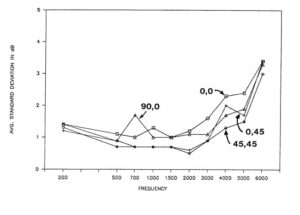In parts 1 and 2 of this blog, issues of stimulus level and inherent variability were discussed. Variability and measurement error were found to be more of an issue of approach, and had nothing to do with whether the assessment was performed at a level that is characteristic of music, or industrial noise. 15 or the vast majority of industrial strength earplugs or muffs in use today.
For part 3 of this blog we need to examine a 1987 article by Killion and Revit that is now more than a quarter of a century old. The year spanning 1987 and 1988 was Mead Killion’s Annus Mirabilis (Latin for Wonderful Year). He came out with the ER-15 Musicians’ earplugs, insert earphones (ER-3A) for more accurate assessment of hearing thresholds, the K-AMP circuit that was the world’s first high-fidelity hearing aid technology, and an article with Larry Revit, based on some of Larry’s master’s thesis work. The article was called … “Insertion gain repeatability versus Loudspeaker Location: You want me to put my loudspeaker WHERE?”
As the article name suggests, Killion and Revit wanted to examine the repeatability of insertion gain measures as a function of angle of incidence of the loudspeaker and of the angle of elevation of the loudspeaker. Years before, E.A.G. Shaw, who was then at the National Research Centre (NRC) in Canada, had exhaustively studied the characteristics of the sound pressures levels that were developed around the human head- the first valid estimates of the “ear canal resonance” or REUR came from the work of Shaw (1974).
I was just entering my undergraduate in mathematics and actually met Shaw for the first time when he gave a guest lecture to my class. The seminar was over my head, but then again, I was only 18 at the time! (We still had grade 13 at that time in Ontario).
But back to Killion and Revit. Their results were also over my head, but this time only by an angle of 45°. Actually it was Larry’s idea to try 45° after having examined Shaw’s angular sensitivity of pressure. Shaw had found that certain angles of presentation of a signal were more susceptible to variability than other angles.
The figure is a reproduction of the original Figure 5 from Killion and Revit’s 1987 publication. It shows the (within subject) standard deviation for 5 subjects at 0°, loudspeaker directly in front of the subject; 45° off to the side; 45° off to the side and 45° elevated above the subject; and then directly above the subject from the ceiling (90°). The directly above 90° measure resulted in a “shoulder bounce,” meaning that there was constructive interference between the incident sound and the early reflection off of the shoulder back to the ear. Other than for assessing shoulders, this loudspeaker location should not be used. The 45° to the side and 45° above the subject location (45°, 45°) is quite a different story.
Since Killion and Revit’s article came out, I have always suspended my loudspeakers at this angle. The improvement is dramatic- the standard deviation is 1 dB or less, at least up to 3000 Hz. With a larger sample size than they used for their 1987 article, the standard deviation would be even less.
This is doubly startling when you consider that insertion gain is a “difference” of two measures- aided – unaided (REAR- REUR); each measure with its own variance. Valid measures such as those obtained with ER-15 musicians’ earplugs discussed in part 1 of this blog could not have been obtained without the use of the 45°, 45° loudspeaker location.






